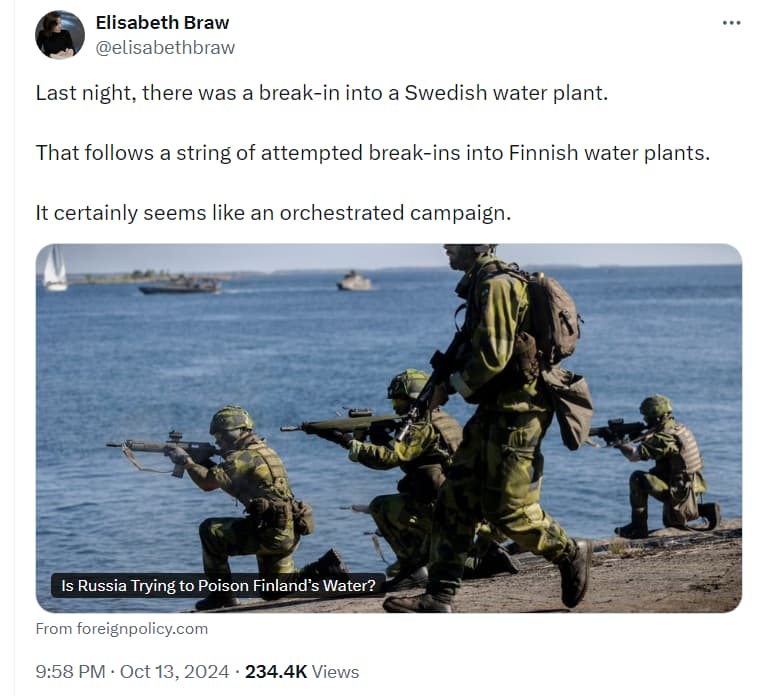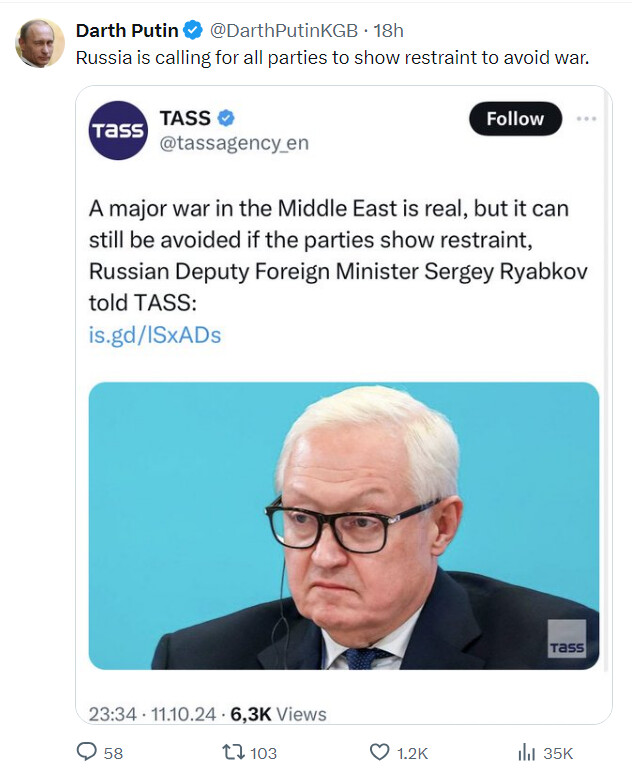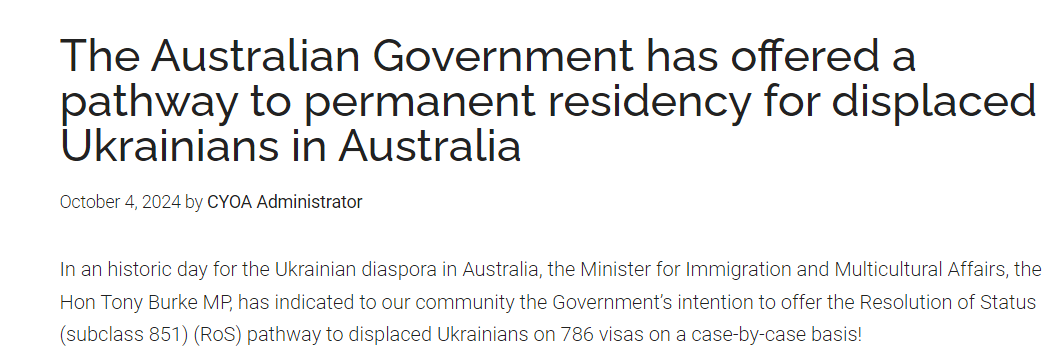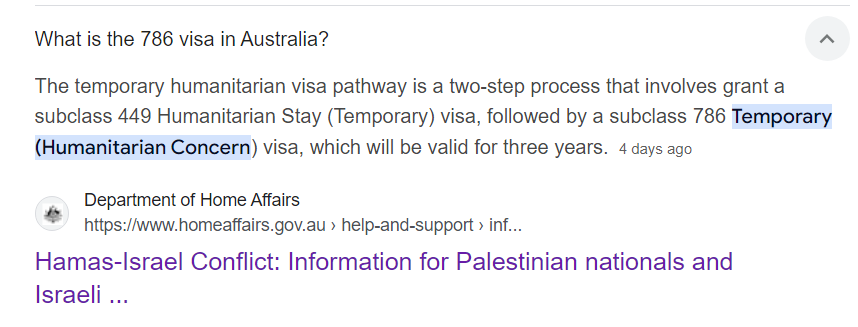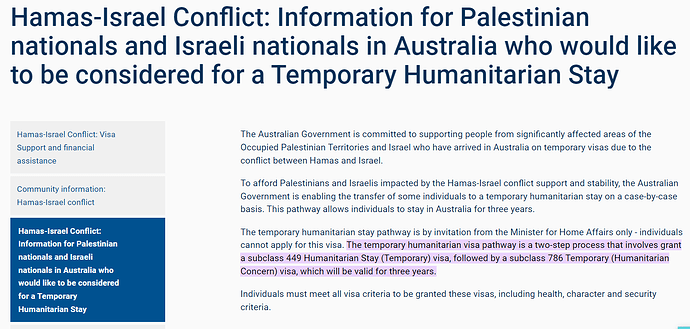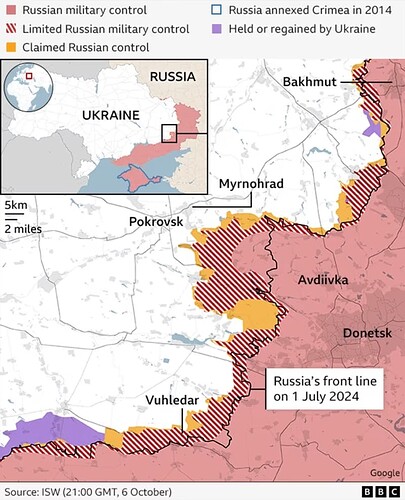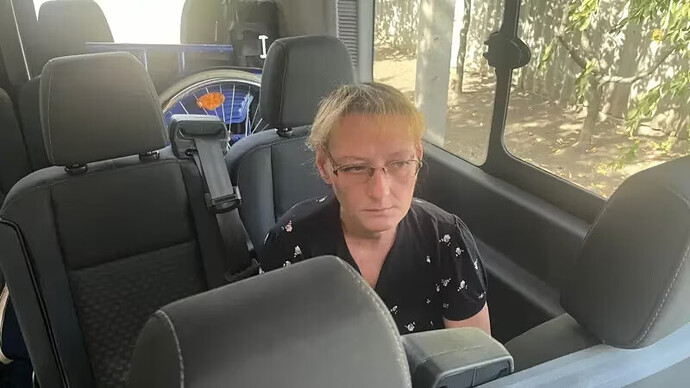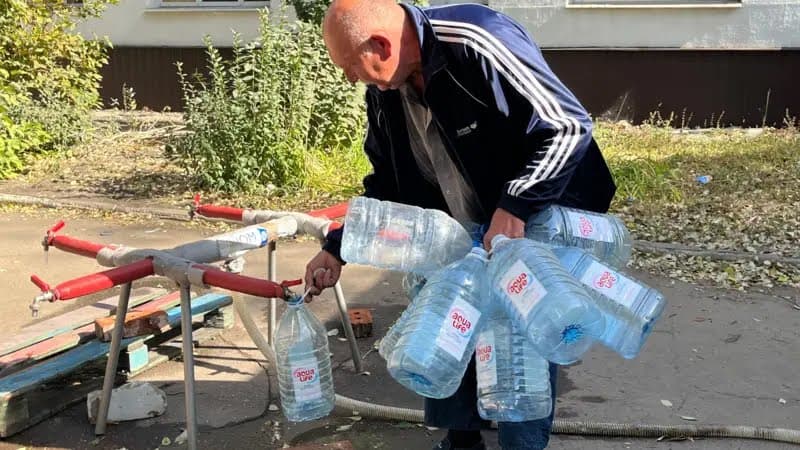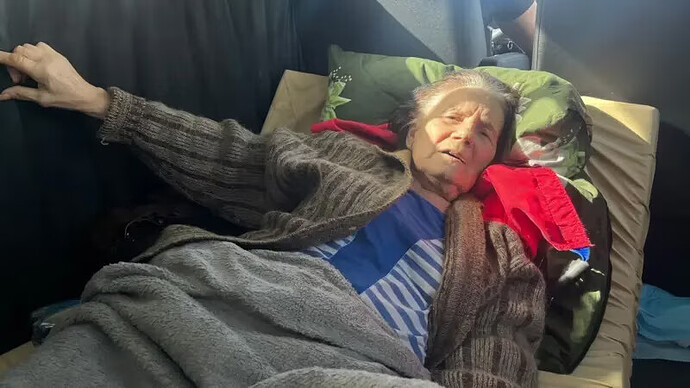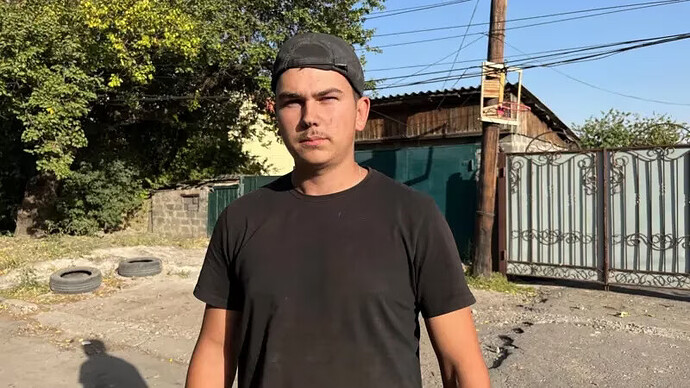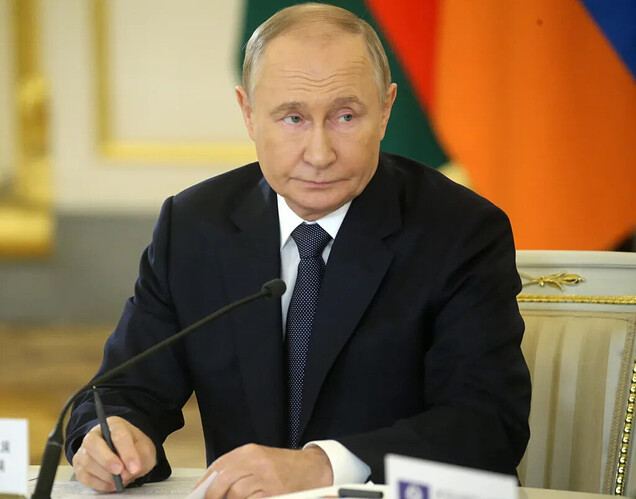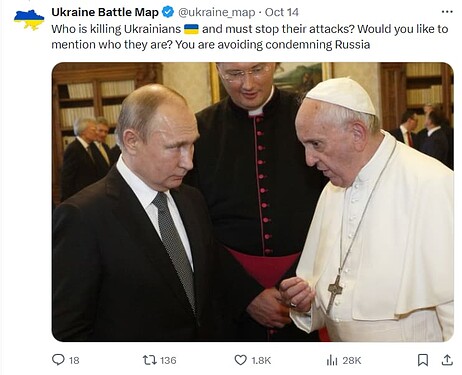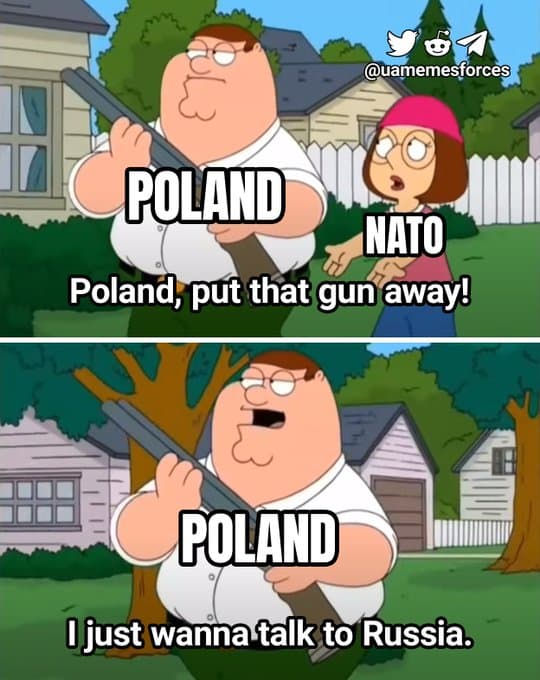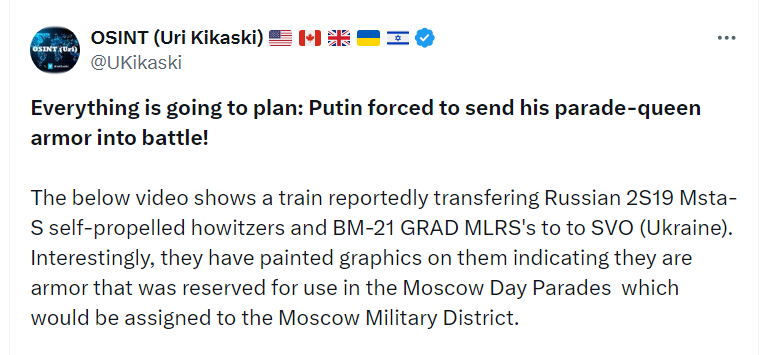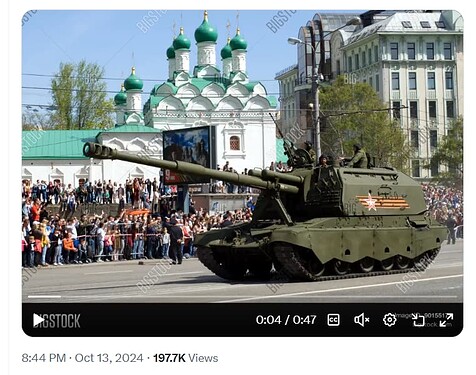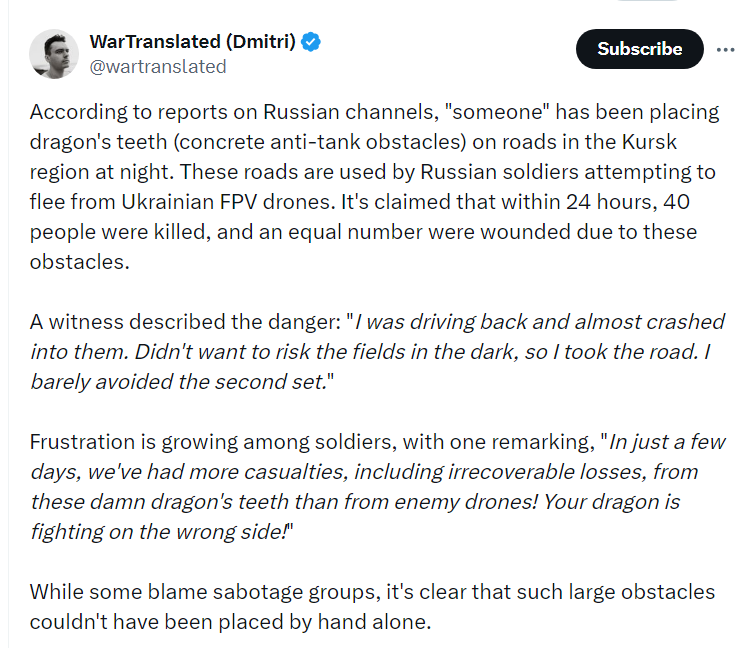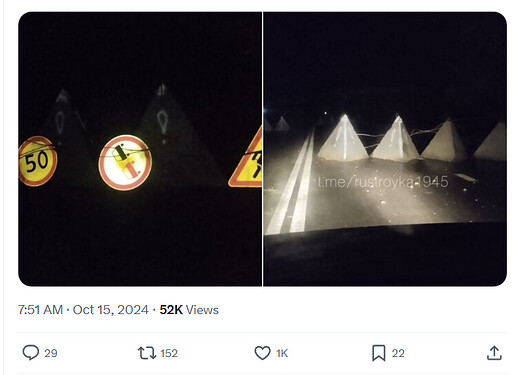Just constant, incessant, hybrid warfare
There is no doubt from these reports that RU is ramping up the pressure. While UA forces are doing an outstanding job of holding on, there is only so much pressure they can absorb, before they break. RU commanders have shown time and again that it doesn’t matter how high the cost in terms of their own people, gradual wright of numbers will win out in the long run, unless UA is given permission to strike RU targets with long range missiles.
2/ Support in the Australian community for Ukraine remains very high. As the 2024 Lowy Poll found:
“Australian public support for assisting Ukraine remains high. The vast majority of Australians (86%) continue to support ‘keeping strict sanctions on Russia’, steady from 2023. Eight in ten (80%) support ‘admitting Ukrainian refugees into Australia’, down four points from last year. Three-quarters (74%) support ‘providing military aid to Ukraine’, steady on last year.”
poll.lowyinstitute.org/report/2024/se…
3/ Australia can certainly afford to provide more support. As the Kiel Institute tracker finds, Australia is a laggard in terms of the percentage of GDP spent on #Ukraine assistance.
4/ The Senate report provides 22 recommendations for the Australian government which cover the following areas:
- Better coordination of Australian assistance across the government.
- The quantity of aid provided.
- The types of military assistance provided and the method by which it is allocated.
- The mandatory consideration of providing military equipment being disposed of to Ukraine.
- Learning lessons from Ukraine.
- Re-opening the Australian embassy in Kyiv.
You can read them all here:aph.gov.au/Parliamentary_…
5/ To its credit, the Australian government has already acted on one of the recommendations, which provides greater certainty to Ukrainians who sought refuge in Australia, providing them with a pathway to Australian citizenship.
6/ However, the Australian government is yet to respond to the other 21 recommendations and it is hoped that it will before going to an election in 2025. One of the most urgent decisions is about sending Australia’s M1 tanks just withdrawn from service to Ukraine. Humanitarian aid for the coming winter is also vital.
7/ You can read my full analysis (for free) of the report into Australia’s support to Ukraine in my latest article at Futura Doctrina.


Bump!
FFS So of all the recommendations for actually supporting Ukraine in its war against Russian invaders, the only one they have actioned is letting Ukrainians - who could otherwise support the war effort - stay in Australia.
They could and should do the least they can do to actually help Ukraine: provide them the retired tanks.
I think the decision is on a case by case basis for Ukrainians who fled the war in 2022, mainly women and children and who are on temporary 3-year Humanitarian visas. Year 12 students are mentioned in the presser.
It’s a big day for Russian irony today.
Ukraine-Russia latest: Kremlin accuses NATO of stoking nuclear tensions as drill with 2,000 troops launched
NATO’s ‘Steadfast Noon’ drill begins the day after US president Joe Biden said he is ready to negotiate on the nuclear issue with Russia
36 minutes ago
Russia has accused NATO of fuelling tensions as the western military alliance launches its annual nuclear drill involving 2,000 troops.
NATO launched the ‘Steadfast Noon’ drill in northern Europe on Monday, which also includes 60 aircraft from eight bases and 13 nations. The drill will be led by Belgium and the Netherlands, and will last around two weeks.
But Kremlin spokesperson Dmitry Peskov has accused NATO of fuelling tensions in light of a “hot war” raging in Ukraine.
“In the conditions of a hot war, which is being waged within the framework of the Ukrainian conflict, of course, such exercises lead to nothing but further escalation of tension,” Peskov was quoted as saying by Russian media.
He also said it would not be possible to hold nuclear arms talks with the US, because of what it perceives as both direct and indirect involvement in the Ukraine war from western powers.
Joe Biden said in a statement yesterday that he is ready to negotiate with Russia, China and North Korea on nuclear issues “without preconditions to reduce the nuclear threat.
Also 1 hour ago.
Kremlin: NATO nuclear exercise is fuelling tensions
Russia has accused NATO of fuelling tensions with their annual nuclear exercise in light of the “hot war” raging on in Ukraine.
The western military alliance kicked off the drills on Monday, which will include 2,000 troops and 60 aircraft from eight bases, the Kyiv Independent reported.
Kremlin spokesperson Dmitry Peskov said on Monday it would not be possible to hold nuclear arms talks with the US, due to what it describes as direct and indirect involvement in Ukraine from western powers.
“In the conditions of a hot war, which is being waged within the framework of the Ukrainian conflict, of course, such exercises lead to nothing but further escalation of tension,” Peskov said according to Breaking The News.
Joe Biden said recently that he is ready to negotiate with Russia, China and North Korea on nuclear issues “without preconditions”.
Fighting Russia - and low morale - on Ukraine’s ‘most dangerous front line’
"We have not been able to stabilise the front,” says Oleksandr
- Yogita Limaye
- Role,BBC News, in Pokrovsk
- 13 October 2024
"This is the most dangerous of all front lines,” says Oleksandr, the head of a medical unit for the Ukrainian army’s 25th Brigade.
We are in the treatment room of a cramped makeshift field unit - the first point of treatment for injured soldiers.
“The Russian Federation is pushing very hard. We have not been able to stabilise the front. Each time the front line moves, we also move.”
We are close to Pokrovsk, a small mining city about 60km (37 miles) to the north-west of the regional capital, Donetsk.
The medics tell us they recently treated 50 soldiers in one day - numbers rarely seen before during the course of this war. The casualties are brought in for treatment at this secret location after dusk, when there is less of a chance of being attacked by armed Russian drones.
The Ukrainian troops have been injured in the ferocious battle to defend Pokrovsk. Just months ago, this was considered a relatively safe place - home to about 60,000 people, its streets lined with restaurants, cafes and markets. Soldiers would often come from the front line to the city for a break.
Now, it feels like a ghost town. More than three-quarters of its population have left.
Since Russia captured the city of Avdiivka in February, the speed of its advance in the Donestk region has been swift. At the start of October, it captured the key city of Vuhledar.
The Ukrainian government agrees with the soldiers we meet on the ground, that fighting around Pokrovsk is the most intense.
“The Pokrovsk direction leads the number of enemy attacks,” Kyiv stated last week - claiming that, in total, the Armed Forces of Ukraine had repelled about 150 “enemy” attacks on most days in the past two weeks.
In the field unit, six miles from the front, army medic Tania holds the arm of Serhii, a soldier with a bloodied bandage covering most of his face, and guides him into an examination room.
“His condition is serious,” says Tania.
Serhii has shrapnel injuries to one of his eyes, his skull and brain. The doctors quickly clean up his wounds and inject antibiotics.
Pokrovsk has been deserted by many of its citizens and is now mostly without power or water.
Five more soldiers arrive soon after - they are uncertain how they received their injuries. The barrage of fire can be so fierce and sudden, their wounds could have been caused by mortars or explosives dropped from drones.
“It’s dangerous here. It is difficult, mentally and physically. We are all tired, but we are coping,” says Yuriy, the commander of all the brigade’s medical units.
All the soldiers we see were injured at different times of the morning, but they have only arrived after nightfall, when it is safer.
Such delays can increase the risk of death and disability, we are told.
Another soldier, Taras, has tied a tourniquet around his arm to stop the bleeding from a shrapnel wound, but now - more than 10 hours later - his arm looks swollen and pale and he can’t feel it. A doctor tells us it might have to be amputated.

IMAGE SOURCE,IMOGEN ANDERSON / BBC
Image caption,The numbers of injured soldiers coming into this makeshift field unit are at a record high, medics say
In the past 24 hours, two soldiers have been brought in dead.
What we see at the field unit points to the ferocity of the battle for Pokrovsk - an important transport hub. The rail link that passes through was used regularly to evacuate civilians from front-line towns to safer parts of Ukraine, and to move supplies for the military.
Ukraine knows what is at stake here.
The threat of Russian drones is ever present - one hovers just outside the medical unit while we are there. It makes evacuations from the front line extremely hard. The building’s windows are boarded up so the drones can’t look inside, but the minute anyone steps out of the door, they are at risk of being hit.
The drones are also a threat to the remaining citizens of Pokrovsk.
“We constantly hear them buzzing - they stop and look inside the windows,” says Viktoriia Vasylevska, 50, one of the remaining, war-weary residents. But even she has now agreed to be evacuated from her home, on the particularly dangerous eastern edge of the city.
She is surprised by how fast the front line has moved west towards Pokrovsk.
“It all happened so quickly. Who knows what will happen here next. I’m losing my nerve. I have panic attacks. I’m afraid of the nights.”
Viktoriia says she has barely any money and will have to start her life from scratch somewhere else, but it is too scary to stay here now.
“I want the war to end. There should be negotiations. There is nothing left in the lands taken by Russia anyway. Everything is destroyed and all the people have fled,” she says.
Viktoriia Vasylevska is one of 14,000 civilians who are being asked to evacuate
We find eroded morale among most of the people we speak to - the toll of more than two and a half years of a grinding war.
Most of Pokrovsk is now without power and water.
At a school, there is a queue of people carrying empty canisters waiting to use a communal tap. They tell us that a few days ago, four taps were working, but now they are down to just one.
Driving through the streets, pockets of destruction are visible, but the city hasn’t yet been bombed out like others that have been fiercely fought over.
We meet Larysa, 69, buying sacks of potatoes at one of a handful of food stalls still open at the otherwise shuttered-down central market.
“I’m terrified. I can’t live without sedatives,” she says. On her small pension, she doesn’t think she would be able to afford rent somewhere else. “The government might take me somewhere and shelter me for a while. But what after that?”
Some people remaining in Pokrovsk are reliant on makeshift communal water taps
Another shopper, 77-year-old Raisa chimes in. “You can’t go anywhere without money. So we just sit in our home and hope that this will end.”
Larysa thinks it’s time to negotiate with Russia - a sentiment that might have been unthinkable for most in Ukraine some time ago. But at least here, near the front line, we found many voicing it.
“So many of our boys are dying, so many are wounded. They’re sacrificing their lives, and this is going on and on,” she says.
From a mattress on the floor of an evacuation van, 80-year-old Nadiia has no sympathy for the advancing Russian forces. “Damn this war! I’m going to die,” she wails. “Why does [President] Putin want more land? Doesn’t he have enough? He has killed so many people.”
Nadiia can’t walk. She used to drag herself around her house, relying on the help of neighbours. Just a handful of them have stayed back, but under the constant threat of bombardment, she has decided to leave even though she doesn’t know where she will go.
Nadiia, 80, can’t walk but has decided to leave the city
But there are those who are not yet leaving town.
Among them are locals working to repair war-damaged infrastructure.
“I live on one of the streets closest to the front line. Everything is burnt out around my house. My neighbours died after their home was shelled,” Vitaliy tells us, as he and his co-workers try to fix electrical lines.
“But I don’t think it’s right to abandon our men. We have to fight until we have victory and Russia is punished for its crimes.”
His resolve is not shared by 20-year-old Roman, who we meet while he is working to fix a shell-damaged home.
“I don’t think the territory we’re fighting for is worth human lives. Lots of our soldiers have died. Young men who could have had a future, wives and children. But they had to go to the front line.”
Roman, 20, is among those whose morale is low
At dawn one morning, we drive towards the battlefield outside the city. Fields of dried sunflowers line the sides of the roads. There is barely any cover, and so we drive at breakneck speed in order to protect ourselves against Russian drone attacks.
We hear loud explosions as we near the front line.
At a Ukrainian artillery position, Vadym fires a Soviet-era artillery gun. It emits a deafening sound and blows dust and dried leaves off the ground. He runs to shelter in an underground bunker, keeping safe from Russian retaliation and waiting for the coordinates of the next Ukrainian strike.
“They [Russia] have more manpower and weapons. And they send their men onto the battlefield like they’re canon fodder,” he says.
But he knows that if Pokrovsk falls, it could open a gateway to the Dnipro region - just 32km (20 miles) from Pokrovsk - and their job will become even more difficult.
“Yes, we are tired - and many of our men have died and been wounded - but we have to fight, otherwise the result will be catastrophic.”
I’ve posted a similar article already. Even a few days later, the headline word “could” is the stumbling block. This is a just a possibility of happening.
Saudi Arabia has a big plan for oil that could hammer Russia’s war machine, economists warn
October 14, 2024 at 6:32 PM GMT+8
The economic cogs pumping Russia’s war machine are at risk of collapsing.
Russia’s war machine in Ukraine has been funded for two and a half years by its vast oil reserves, even in the face of rising sanctions that have cut it off from key Western customers. However, a bold move by Saudi Arabia could jeopardize that strategy.
Saudi Arabia is reportedly planning to abandon its unofficial price target of $100 per barrel for crude oil in a bid to grab market share by upping supply, according to a Financial Times report in September.
A potential increase in supply set the price of OPEC+ oil, which represents 60% of oil traded globally, tumbling in the wake of the news, suggesting the post-COVID era of high-price fossil fuels could be coming to an end.
The country is planning to challenge the U.S. crude industry, where oil extraction is more expensive, while implicitly confirming it is difficult to charge more than $100 a barrel for crude. A Saudi minister warned in October that prices could fall as low as $50 a barrel.
The biggest victim, however, could very well be Russia’s war machine.
“For Russia, this is the worst of both worlds,” Luke Cooper, a research fellow at the London School of Economics, wrote for the IPS journal.
"Unlike the United States, it has an oil-dependent economy, which benefits from the cartel power of OPEC+. Yet, unlike Saudi Arabia, its oil is not cheap to extract, making it poorly equipped to deal with low-price conditions.
“This drives a short-term escalatory logic for Russia’s war on Ukraine, requiring rapid battlefield successes prior to the emergence of low-price oil market conditions.”
Cooper pointed out that because Saudi Arabia and Iran’s oil wells are closer to the surface, they are cheaper to extract. Russia, on the other hand, has to spend more on production costs to extract its deep oil wells, reducing its margins.
Russia’s flagging war machine
Russia was hit with sanctions from the West in the wake of its February 2022 invasion of Ukraine. These measures have proved more harmful to the countries leveling the sanctions than to Russia itself.
Germany, which long relied on cheap Russian fuel imports, has faced a drawn out recession in its production sector, while its economy as a whole is expected to shrink for the second year in a row in 2024.
Meanwhile, Russia’s economy grew 3.6% in 2023 and expanded at an annualized rate of 5.4% in the first quarter of 2024. However, the country has been forced to be a price-take in available markets, including China, as a result.
Stefan Hedlund, director of research at the Centre for Russian and Eurasian Studies at Uppsala University, thinks Russia’s growth figures are a mirage clouded by Russia’s wartime spending, which has artificially inflated GDP.
“The simplest explanation is the right one: Russia’s GDP growth stems from a massive boost in spending on defense,” Hedlund wrote in Geopolitical Intelligence Services.
"Large amounts of money are being funneled to contracting Russian soldiers, many of whom will be killed in Ukraine, and to the production of military hardware, much of which will be destroyed on the battlefield. Neither of these outputs can be justified in the long term.”
Writing for Project Syndicate, economist and author Anders Åslund warned Russia may need to successfully conclude its war in Ukraine by the end of 2025 to prevent economic catastrophe.
Russia’s lucrative weapons exports have collapsed amide more demand from its own troops, while the country is also dealing with “hidden inflation” and constraints to its budget deficit, Åslund wrote.
There are a number of factors that will determine whether Russia’s ability to continue selling oil at the price needed to sustain its war machine, LSE’s Cooper says.
That includes the extent of the green transition, how aggressively Saudi Arabia increases its oil exports, and whether Israel and Iran can step away from the brink of all-out war in the Middle East.
“If these factors evolve in such a way as to produce an oil price collapse that is equivalent in scale to 2014 – 2016, the Russian regime may encounter difficulties financing its war economy,” said Cooper.
Not to overlook concerns at supply from Middle East oil producers in the context of conflicts in the region. The Iran Foreign Minister is doing the rounds in the capitals of Arab oil producing States.
There are some additional comments in the report by the two ALP Senators on that Senate Committee. The two Greens Senators on the Committee also made additional comments.
Margarita Simonyan says Russian elites should be wealthy
I think that the russians instinctively know that the outcome of the war and what follows may be in large part decided by the US election. And they are cocky, feeling sure of things falling their way and of their victory.
Meanwhile, dubious articles parroting russian propaganda and making spurious claims about Ukraine secretly wanting to make peace are now appearing more frequently. It is the state propagandists job to push ideas that a road to a peace deal is open while starting to shape the maximalist goals.
So it comes as no surprise that Margarita Simonyan openly states that she wants Odesa, the third most populous city in Ukraine after Kyiv and Kharkiv. If she is saying she wants Odesa, this means that Putin wants Odesa. Now that he thinks Ukraine is weakening, he is getting greedy.
The Gall of these ■■■■■■■.
What’s happening?
Now that turret is going to look glorious when blown into the clouds
